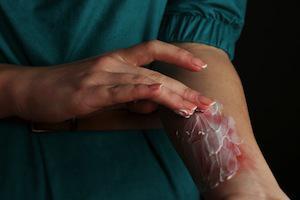
Causes of Burns
Burns injuries can be caused by chemicals, electricity, heat, radiation or sunlight. Those involving scalds from hot liquid or steam, the handling flammable liquids or gasses, or those obtained while building a fire are the most commonly experienced burns. Children are often at the greatest risk, particularly for hot liquid burns or burns from touching something that is extremely hot. Great care should be taken to prevent such injuries.
Types of Burns
Knowing the types of burns is important in establishing when and if medical treatment should be sought after a burn injury. The three types of burns include:
- First-degree burns: affects only the outer layer of skin and will include redness, swelling, and pain;
- Second-degree burns: affects the outer layer and the layer underneath and may include swelling, blisters, splotchy or red or white skin and pain; and
- Third-degree burns: damages or destroys the deepest layer of skin and may extend to the tissues underneath and can cause difficulty breathing, shock, or even death.
Burn Treatments
Most first-degree burns are relatively minor and can be treated at home with cool running water, over-the-counter pain medication, and antibiotic ointment. However, even first degree burns can become infected. If you notice any signs of oozing from the wound, pain increases, or if there is excessive redness and swelling, you should seek treatment from a doctor. In addition, large first-degree burns, particularly those that occur on the hands, feet, face, groin, buttocks, or major joint should be evaluated by an emergency room physician.
Second-degree burns may also sometimes be treated at home, as long as they are no larger than 3 inches in size. Larger burns, particularly those that occur to the hands, feet, face, groin, buttocks, or major joint should be immediately treated by an emergency room physician. Additionally, if a large blister develops, you should visit the emergency room department or contact your primary care physician.
Third-degree burns are extremely severe, and they can affect underlying fat layers, bone or muscle. Areas of the skin may be charred black or white, and the person may have trouble breathing or may suffer from shock or death. In this instance, an immediate call to 911 should be made. While waiting for emergency responders, the Mayo Clinic says you may cover the area in a cool, moist, sterile bandage, but that you should not douse or immerse the area in cold water.
Serious burns, particularly third-degree burns, may result in long-term treatment. Debridement of the wound and skin grafting may be needed. Fluids and nutrition may need to be administered during the healing phase as well to aid in recovery.
Suffered a Burn Injury? Seek Qualified and Experienced Legal Help
Electric shock from defective equipment, burns from explosions or fires during automobile accidents, and other situations involving third party negligence may provide grounds for personal injury liability and compensation. The experienced Appleton personal injury attorneys and Green Bay personal injury attorneys at [[title]] can help pursue your serious burn injury or wrongful death case. Schedule your free initial consultation by calling 920-739-7366 today.
Sources:
https://www.nlm.nih.gov/medlineplus/burns.html
http://www.ameriburn.org/resources_factsheet.php
http://www.mayoclinic.org/first-aid/first-aid-burns/basics/art-20056649



